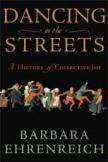Communal Ecstasy!
Dancing in the Streets is a study of the gatherings of people for frenzied communal festivity, or what the author Barbara Ehrenreich calls “collective joy,” throughout the ages. It is a thoroughgoing piece of social history. The book should also appeal to students of religion, drama, politics, social psychology and even those boys and girls who, to paraphrase the rocker Cyndi Lauper, “just wanna have fun.” It eventually prompts the reader to wonder why, in a world in which so much entertainment is so readily available, we seem to have so few experiences of genuine festivity today. This delightful book provides a few answers.
Ehrenreich’s survey of collective joy begins by offering some correctives to the image of such ceremonies as mindless orgies of sexual abandon or lawless misconduct. Granted, the list of ingredients for these ecstatic rituals and festivities might look like the familiar party formula: “music, dancing, eating, drinking or indulging in other mind-altering drugs, costuming and/or various forms of self-decoration, such as face and body painting,” while the longer and more elaborate events might include “processions, religious rituals, athletic and other contests, dramatic performances, and comedy.” The original intent of such activity, however, was quite specific. The dancing celebrants strove for a blissful loss of their sense of individuality as they surrendered to the joyous frenzy of the group and, in many cases, appeared to enter into an ecstatic union with the divine. Such ceremonies, Ehrenreich is quick to point out, tended not to be spontaneous events but were “deliberately planned, organized and at all times subject to cultural rules and expectations,” often connected to seasonal changes, initiation rites, weddings, funerals, coronations or other public events that “could be anticipated, for weeks or months and carefully prepared for.”
Over the centuries, these ceremonies included the hunting rituals of primitive tribes, the Dionysian rites of ancient Greece, the ceremonies of the mystery religions of ancient Rome, the surprising pattern of “church dancing” in medieval Catholic church services—which led to frequent church holidays, the Feast of Fools and the numerous carnivals that have survived into modern times.
Ehrenreich attributes the subsequent, and perhaps inevitable, suppression of such revelry to the determination of the elite to control the masses. For the ruling classes, the problem with such ecstatic rituals was “their leveling effects, the way in which they dissolve rank and other forms of social difference.” The games of “social inversion,” in which masters would serve the slaves and bishops traded places with tavern-keepers; the masks and costumes; and especially the participation in undignified dancing and buffoonery threatened to undermine the positions of those in authority. Ehrenreich describes the punishments administered to such revelers by the Roman imperial government, the Catholic hierarchy, the Puritan rule in England and New England, the earnest leaders of the French Revolution, the regimes of ancient China and the Wahhabist repression of the ecstatic rituals of Sufism in the Arab world. She also includes reports of the shocked reaction of missionaries to the wildly ecstatic behavior among native peoples, which the churchmen systematically suppressed as part of their efforts to convert the “savages” to Christianity and Western civilization.
Ehrenreich illustrates how the opposition to revelry gathered further strength in the early modern age not only from the rise of the work ethic in the emerging capitalistic economies but also with the appearance of a more regimented military culture at the same time. Oliver Cromwell and other Calvinist military leaders favored the new techniques of gun volleys, which turned soldiers into a sort of assembly line of artillery, in contrast to the cavalier martial techniques of archery, swordplay and horse-riding, which had allowed both officers and common soldiers more leisure. The work ethic and the military ethic both aimed at efficient use of time and energy, adding more reasons to suppress any idle celebrations.
Perhaps the most intriguing section of Dancing in the Streets is the author’s account of the rampant spread of depression, or “melancholy,” at approximately the same time that group celebrations were outlawed. Ehrenreich documents what she calls an “epidemic of depression” in 16th- and 17th-century Europe and attributes it not only to a new emphasis on individuality inherent in Protestantism’s portrayal of the unmediated confrontation of the individual sinner with a demanding God but also to the simultaneous “decline in opportunities for pleasure, such as carnival and other traditional festivities.”
Ehrenreich’s examination of contemporary “collective joy” is much less satisfying than her historical research. She observes the arrival of the rock concerts in the 1960’s, but concludes that the tribal ecstasy of the Woodstock era has been co-opted by commercialization as tamed renditions of rock anthems can now be heard in television commercials or as background music in shopping malls. She suggests that major sporting events—the tailgaters’ consumption of food and drink; the face-painting, wigs, team shirts, hats and other fan paraphernalia; the communal cheering, the “waves” and other rituals in the stands; the rock music played over the loudspeakers; and even the rowdiness of the “hooligans” at some venues—approximate more closely the communal joy of carnival. Ehrenreich’s search might have proven more rewarding if, instead of commercial mainstream phenomena, she had observed some ethnic parades, the club scene and circuit parties, Gospel and Pentecostal religious services and activities even further on the fringe. Somewhere out there, the spirit of Dionysius, the immortal demigod of frenzy and ecstasy, may still be dancing.
This article also appeared in print, under the headline “Communal Ecstasy!,” in the May 28, 2007, issue.








